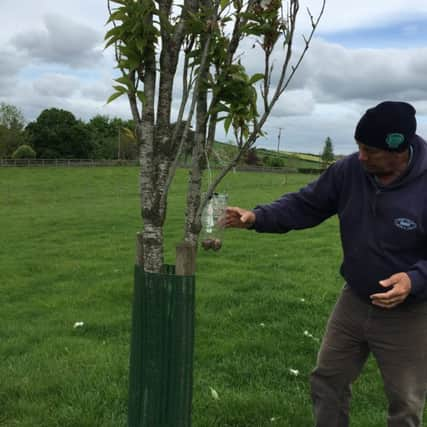Lambs thriving and extraordinary grass growth being reported


Grass growth is making up for the slow start early in the season and already six acres have been baled for silage to keep it from getting ahead of the lambs. For the main crop silage the grass is closed off from grazing for six weeks before cutting so harvesting of this will start in two weeks’ time.
Samples for faecal egg counts are continuing to be forwarded to the lab every two weeks. In the most recent results coccidial oocysts were apparent, and Deccox® 6% was added to the creep feed. Crosby is considering his strategy for next year and will consider starting the Deccox® earlier in the season. This will be discussed in detail with his vet.
Advertisement
Hide AdAdvertisement
Hide AdHe has used a white drench for Nematodirus and samples indicated no signs of this disease at all.
So far very few flies have been observed in the fly traps and only a few maggots in one of the traps. Crosby believes it may be the end of June before fly treatment is applied.
Aurelie Moralis, Veterinary Consultant with Zoetis, outlines the vast range of flies that are found on farm and points out that their effects include wool loss, skin damage, poor performance, weight loss, reduced production, increased treatment costs and even death in sheep or lambs that are struck with blowfly maggots.
There are also the indirect costs from disease transmission.
Treatment of flies include:
Advertisement
Hide AdAdvertisement
Hide AdFly & Lice Spot On™ – a 1% topical application licensed for established blowfly strike on sheep. One application will ensure blowfly larvae are killed in a short time. In the case of more advanced strike lesions, clipping out of stained wool before treatment is advisable.
Dysect™ Sheep 12.5 g/l Pour-On is a topical pour-on for the control and treatment of blowfly strike on sheep and lambs, providing protection for up to eight to 10 weeks. It also reduces the incidence of headfly strike in sheep and lambs for up to six weeks. Because alphacypermethrin is retained in the wool grease of the fleece, it is recommended that the product be applied to sheep with a minimum wool length of 1.0 cm.
Pour-on and Spot-on treatments are simple, low labour, stress free methods of application, applied on the back or on one spot in the middle of the back.
Aurelie’s advice is to start early – treat as soon as flies begin to emerge.
Advertisement
Hide AdAdvertisement
Hide AdTo determine this Zoetis have set up #parasitewatch on Twitter (@sheep_farmers) and Facebook (Sheep Farmers) whereby a number of farmers around the UK, including Crosby Cleland, are using fly traps and reporting when the flies begin to arrive in large numbers.
Farmers can also see how to make these simple fly traps on the #parasitewatch site in order to determine the fly population in their own area. She added: “Don’t wait until flies have become a nuisance to livestock and people alike. Setting up a few DIY traps around the farm can give an early indication that treatment may be needed.”
Comments from other #parasitewatch participants on Twitter include:
Dorset farmer – fly strike bad, worst I’ve seen.
Exeter – flies really starting to build up and only a handful in the trap at start of May.
Wales – high levels of cocci and some evidence of Nematodirus.
Oxford – a post drench sample showed that moxidectin (Cydectin®) has been fully effective.